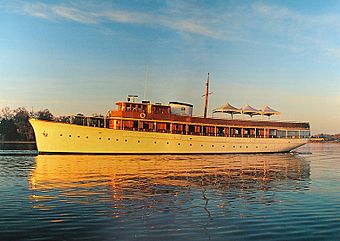USS Aquamarine facts for kids
class="infobox " style="float: right; clear: right; width: 315px; border-spacing: 2px; text-align: left; font-size: 90%;" |+USS Aquamarine | colspan="2" style="text-align: center; font-size: 90%; line-height: 1.5em;" |
|}
USS Aquamarine (PYc-7) was a special ship that started as a fancy yacht named Siele. It was built in 1926. During World War II, the U.S. Navy bought it and renamed it Aquamarine. Instead of fighting, it helped scientists study underwater sounds. After the war, it became a private yacht again, changing names to Sea Wolf and then Miss Ann. Today, it is recognized as an important historical ship.
Contents
- Building a Luxury Yacht
- Life as a Private Yacht
- Serving in the Navy
- Back to Private Life
- The Miss Ann Era
- Images for kids
Building a Luxury Yacht
The yacht Siele was built by the Pusey and Jones Corporation in Wilmington, Delaware. Construction began on December 1, 1925. The ship was launched on April 10, 1926. It was delivered to its first owner, John H. French, a banker, on July 13, 1926.
The Siele was made of steel, with beautiful teak wood on its decks. Its hull was divided into seven waterproof sections. The main deck had a dining room, kitchen, and living room. Below deck were six staterooms for guests, each with its own bathroom. The rooms were decorated with fancy walnut wood and large windows. The crew had their own living areas at the front of the ship.
The yacht was powered by two large diesel engines. Each engine had 300 horsepower, giving the ship a total of 600 horsepower. These engines turned two bronze propellers, allowing the yacht to move through the water.
Life as a Private Yacht
When it was first built, Siele was registered in Detroit, Michigan. It had a crew of twelve people. In 1935, its call sign, which is like a ship's unique phone number, was changed. John H. French owned the yacht until 1940.
In 1940, Siele was sold to Robert H. Wolfe, a newspaper publisher from Ohio. Mr. Wolfe renamed the yacht Sea Wolf, after a smaller yacht he used to own.
The Navy bought Sea Wolf on January 13, 1941. It was officially put into service as Aquamarine on April 9, 1941. The ship was named after the beautiful aquamarine gemstone.
Instead of being a fighting ship, Aquamarine was sent to the Naval Research Laboratory (NRL) in Washington, D.C. Its main job was to help with experiments, especially those involving underwater sound. Most of its work happened on the Potomac River and in Chesapeake Bay. It also traveled to New London, Connecticut, and the Florida coast for experiments.
Aquamarine helped scientists develop new ways to make ships quieter. One experiment involved creating a cloud of bubbles at the front of the ship. This bubble cloud helped to reduce the sound a ship made, making it harder for enemies to detect. This technique was later used on other Navy ships. From 1945 to 1946, Aquamarine also served as a special support ship for the presidential yachts Potomac and Williamsburg.
Aquamarine was taken out of Navy service on June 21, 1946. It was then given to the United States Maritime Commission to be sold.
Back to Private Life
The Navy had made many changes to the ship. These changes helped it carry a Navy crew and conduct scientific experiments. After its Navy service, the ship was returned to its previous owner, Robert H. Wolfe. However, it was heavily modified and no longer suitable as a luxury yacht.
In 1954, the ship was sold to Ennolls A. Stephens, who owned The Tides Inn in Irvington, Virginia. Mr. Stephens renamed the ship Miss Ann.
The Miss Ann Era
Mr. Stephens had to do a lot of work to rebuild major parts of the vessel. He worked with a naval architect to restore the ship for private use. They made many changes, including adding a new bow and stern, which made the ship about 3 feet longer. They also removed parts that the Navy had added and restored much of the original woodwork.
Mr. Stephens noted that the Navy had installed "two cylinders, approximately three feet in diameter each, through the deck and all the way through the ship." These were likely part of the research to create a bubble cloud to reduce noise.
Later, the Coast Guard found that Miss Ann did not meet the rules for carrying passengers. Mr. Stephens spent a lot of money to make repairs below the waterline. This required removing and storing some of the original cabin work.
In 2008, Miss Ann was sold again to new owners. They began using her for charter services on the Potomac River. In 2019, she was docked at Evans Island in Monroe Bay, Colonial Beach, Virginia.
Images for kids
Miss Ann in 2010
| History | |
|---|---|
| Name |
|
| Builder | Pusey and Jones Corporation, Wilmington, Delaware |
| Laid down | 1 December 1925 |
| Launched | 10 April 1926 |
| Acquired |
|
| Commissioned | by Navy 9 April 1941 |
| Decommissioned | by Navy 21 June 1946 |
| Identification |
|
| Fate | Charter Service on the Potomac River (2008) |
| General characteristics | |
| Type | Yacht |
| Tonnage | 183 GRT, 124 Net tons |
| Displacement | 220 long tons (224 t) |
| Length |
|
| Beam | 20.6 ft (6.3 m) |
| Draft | 7 ft (2.1 m) |
| Depth | 9.6 ft (2.9 m) |
| Depth of hold | 9 ft 7 in (2.92 m) |
| Propulsion | 2 x 300 hp Winton diesel engines, 2 shafts, 600 bhp (447 kW) |
| Speed | 12 knots (22 km/h; 14 mph) |
| Complement |
|
| Armament | 2 × .30 caliber guns |
|
Siele (motor yacht)
|
|

Miss Ann in 2010
|
|
| Location | Tides Inn, Carter Creek, Irvington, Virginia |
| Built | 1926 |
| Architect | B. T. Dobson; Pusey & Jones Shipyard |
| NRHP reference No. | 98001310 |
| Added to NRHP | 12 November 1998 |




